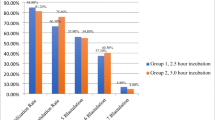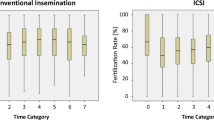Abstract
This prospective study was designed to evaluate and clarify further whether the position of the polar body (PB) in relation to injection site during intracytoplasmatic sperm injection (ICSI) has an impact on fertilization and developmental rates and consequently clinical pregnancy outcome. The study included 264 patients undergoing 306 ICSI cycles from September 2007 to January 2009 performed by the same practitioner. Of all oocytes retrieved, 1736 were in metaphase II (MII). From every woman reaching ovum pick up, all MII-collected oocytes were allocated to 1 of the 4 groups according to PB orientation. In group A, MII oocytes were injected with the PB at 6 o’clock, group B with the PB at 7 o’clock, group C with the PB at 11 o’clock, and a group D with the PB at 12 o’clock. A significantly higher proportion of fertilized oocytes were produced from oocytes that had been injected with the PB at 11 o’clock (79.2%) as compared to those at 6 o’clock (70.5%), 7 o’clock (64.4%), and 12 o’clock (68.8%). Furthermore, embryos derived from oocytes that were injected with the PB at 11 o’clock appeared to be of higher quality score than those of the other groups of oocytes. A higher clinical pregnancy rate (28.7%) was obtained after the transfer of embryos from oocytes that had been injected with the PB at 11 o’clock. Given the higher fertilization, developmental, and pregnancy rate in the 11 o’clock group, it is suggested that this may be the preferred position of the PB at ICSI.
Similar content being viewed by others
References
Andersen A, Goossens V, Ferraretti P, et al. Assisted reproductive technology in Europe 2004. Hum Reprod. 2008;23(4):756–771.
Palermo GD, Joris H, Devroy P, Van Steirteghem C. Pregnancies after intracytoplasmic injection of single spermatozoon into an oocyte. Lancet. 1992;340(8810):17–18.
Nagy ZP, Liu J, Joris H, et al. The influence of the site of sperm deposition and mode of oolemna breakage at intracytoplasmatic sperm injection on fertilization and embryo development rates. Hum Reprod. 1995;10(12):3171–3177.
Tarlatzis BC, Billi H. Survey on intracytoplasmatic sperm injection: report from the ESHRE ICSI task Force. Hum Reprod. 1998;13(suppl 1):165–177.
Hardarson T, Lundin K, Hamberger L. The position of the meta-phase II spindle cannot be predicted by the location of the first polar body in the human oocyte. Hum Reprod. 2000;15(6): 1372–1376.
Wang WH, Meng L, Hackett RJ, Oldenbourg R, Keefe DL. The spindle observation and its relationship with fertilization after intracytoplasmatic sperm injection in living human oocytes. Fertil Steril. 2001;75(2):348–353.
Avery S, Martyn B. Effect of the position of the meiotic spindle on the outcome of intracytoplasmatic sperm injection. Hum Fertil. 2003;6(1):19–22.
Blake M, Garrisi J, Tomkin G, Cohen J. Sperm deposition site during ICSI affects fertilization and development. Fertil Steril. 2000;73(1):31–37.
Tournaye H, Liu J, Nagy Z. Intracytoplasmatic sperm injection (ICSI): the Brussels experience. Reprod Fertil Dev. 1995;7(2): 269–279.
LeMaire-Adkins R, Radke K, Hunt PA. Lack of checkpoint control at the metaphase/anaphase transition: a mechanism of meiotic nondisjunction in mammalian females. J Cell Biol. 1997;139(7): 1611–1619.
Fulka J Jr, Karnikova L, Moor RM. Oocyte polarity: ICSI, cloning and related techniques. Hum Rerpod. 1998;13(12): 3303–3305.
Van der Westerlaken LA, Helmerhorst FM, Hermans J, Naaktgeboren N. Intracytoplasmatic sperm injection: position of the polar body affects pregnancy rate. Hum Reprod. 1999;14(10):2565–2569.
Palermo GD, Cohen J, Alikani M, Adler A, Rosenwaks Z. Intracytoplasmatic sperm injection: a novel treatment for all forms of male infertility. Fertil Steril. 1995;63(6):1231–1240.
Wang Q, Sun QY. Evaluation of oocyte quality: morphological cellular and molecular predictors. Reprod Fertil Dev. 2007;19(1):1–12.
Sousa M, Tesarik J. Ultrastructural analysis of fertilization failure after intracytoplasmatic sperm injection. Hum Reprod. 1994;9(12):2374–2380.
Stoddart NR, Fleming SD. Orientation of the first polar body of the oocyte at 6 or 12 o’clock during ICSI does not affect clinical outcome. Hum Reprod. 2000;15(7):1580–1585.
Author information
Authors and Affiliations
Corresponding author
Rights and permissions
About this article
Cite this article
Anifandis, G., Dafopoulos, K., Messini, C.I. et al. Effect of the Position of the Polar Body During ICSI on Fertilization Rate and Embryo Development. Reprod. Sci. 17, 849–853 (2010). https://doi.org/10.1177/1933719110372421
Published:
Issue Date:
DOI: https://doi.org/10.1177/1933719110372421




